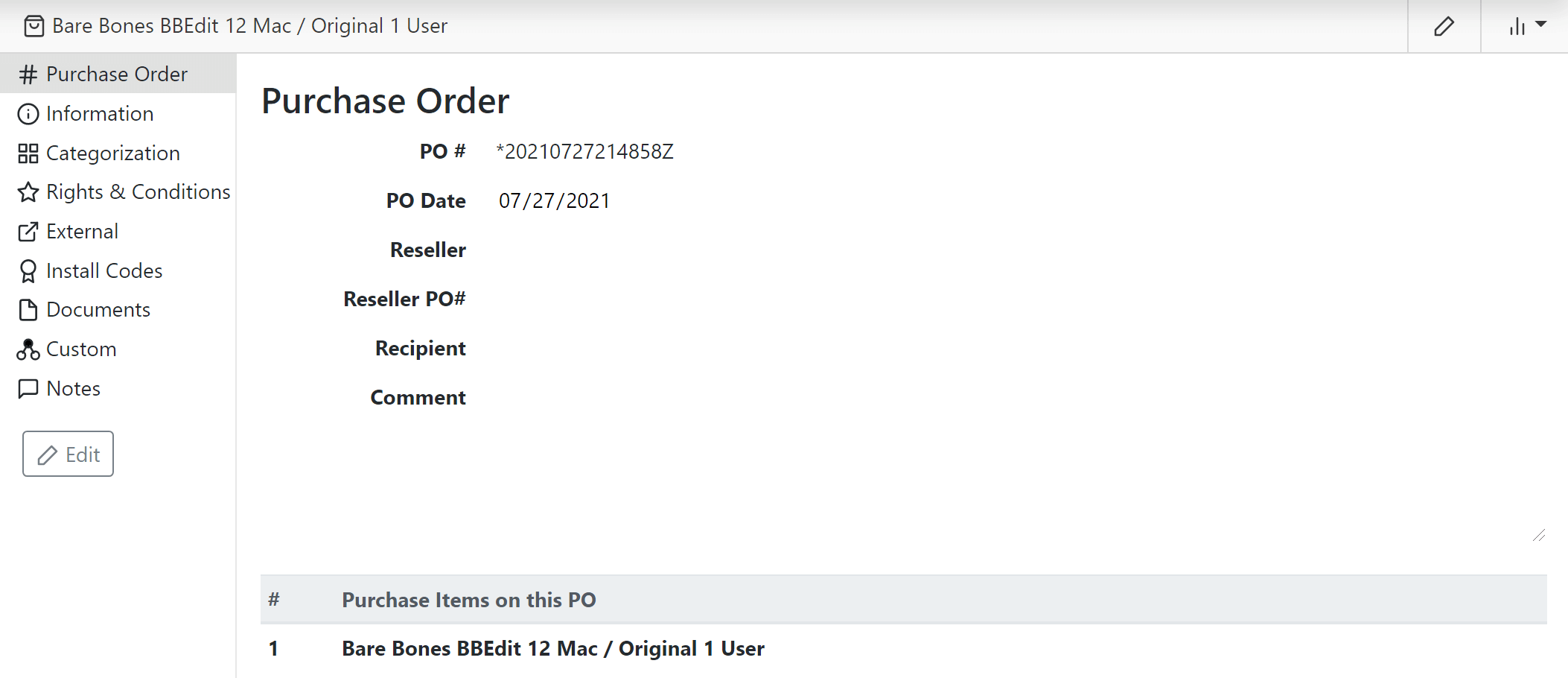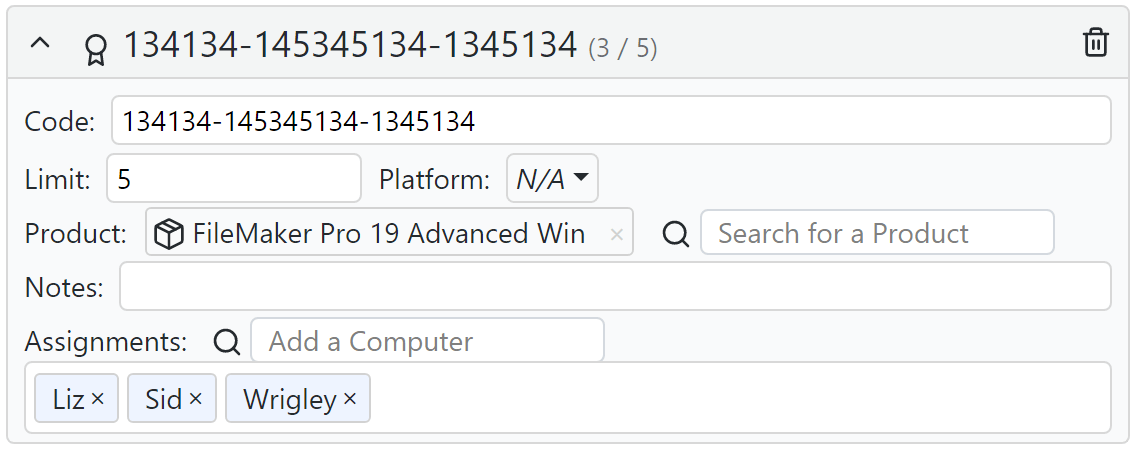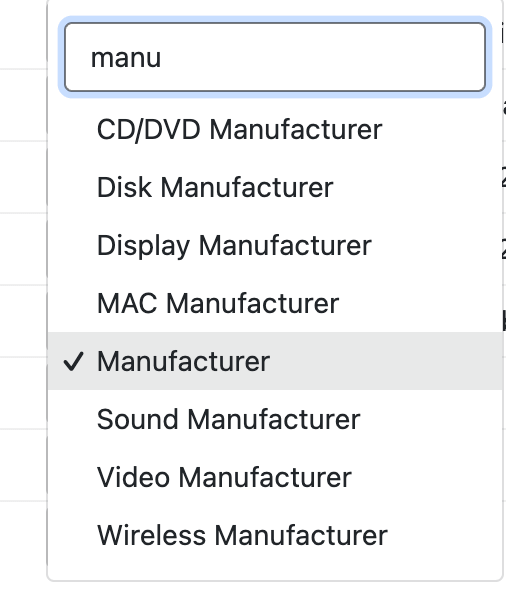Purchases
The Purchases page is very similar to the Computers and Devices pages. Please see the Basic Concepts of that linked page for some overview. While some items are restated below, basic understanding of the UI is assumed by the point you start working with Purchase records.

Main Screen
The main Purchases window shows a list of all purchase records in the system (or potentially those you have access to view).
Top Ribbon
In the top left you will see a button to toggle the display of the left hand navigation pane on and off. Next to this is an indication of what scope is applied due to selection of a Folder in the navigation, as well as a total number of Purchases in the current selection. On the right side are several tools.
Clicking the + button will open a small modal to add a new purchase. You must enter a PO Number for the new record (make one up if you don't have an actual PO#). If you are adding an additional purchase to a PO, also set the PO Item number (i.e. line item number). You'll then be taken to the Details page for the new record to add in the other data.
Next is the Arrange Columns button ◫. This will bring up a modal where you can choose which data fields will be displayed as columns and what oder they appear in. You can also select the Grouping field to use, if any. Grouping allows for powerful display of the purchase records by any available field in the database, like Department, Cost Center, Reseller, etc. By grouping and then sorting by another column, you can achieve sub-sorting of objects.
The More menu ⁞ ▾ contains a number of other actions. Many items will be grayed out if you do not have one or more Purchases selected in the main pane.
- Open Details - Same as clicking on the purchase item/name, go to the details page for the record.
- Quick Edit - Open the quick edit dialogue which allows change of any number of fields on any number of records at once.
- Scripts - Sub menu of Admin Scripts you can run on the selected computer(s).
- Import - This choice starts an import process for pulling in records from CSV.
- You can choose from a number of formats to Download the current displayed list of object to. This will save only the displayed rows and columns. It will not show the Grouping if one is set.
- Delete - Remove the purchase record(s) from the database.
- When used on a Detail page, if you have any Forms defined you can easily flip between these views.
Left Navigation
The left hand navigation for Purchases contains multiple sections of items that let you limit the displayed records to certain conditions.
- Purchase Type allows you to select one or more types of purchases to view. Selecting none is the same as selecting all.
- Folders - These are groupings of purchases as you might expect. You can click the + to add a new folder, or right click on a folder to renmae or delete it. Note that there are a number of fields in purchase records like department and cost center, and you can use Filters for things like year of the purchase. The primary purpose then for Folders is not so much organizational as Access Rights when delegating permissions at a granular level.
- Filters - You can use Filters to set display criteria for the main purchase list. Only one Filter can be active at a time. You can use the one-time filter to apply custom criteria on the fly without saving it. Click the + to add a new filter, or right click a filter to edit, duplicate, or delete it. The can be useful for example to show all purchases related to a few different cost centers, but not all inclusive to a department.
- Tags - Once a Tag is created it will appear in this list. Tags are initially made by adding one to a Computer or Device (note they are not shared across these data tables). You can then drag and drop items onto a tag to add that tag to the items. Because Tags are many:many, a computer could be under multiple tags not just one like Divisions. Like Divisions and Filters, selecting a tag will filter the displayed items.
Main Pane
The large area of the page where the list of purchases is displayed. You can change the displayed columns using the Arrange Fields ◫ button in the ribbon. Click any column header to sort by that column. Click on a purchase Name to view its detail record. Click anywhere else on the line to select that row, and then shift or control click to select additional rows. With multiple selections you can then use the more actions menu ⁞ ▾ in the ribbon to make bulk edits or run scripts. Right click on a purchase to access these actions on one record, choose a Form to display the record in, or Quick Edit a number of selected records.
You can also use the Search bar in the header to search for a purchase by any of the column data. Combining the Scope and Folders filtering options along with Grouping allows for robust and detailed results that can then be further quick searched.
Details View
When viewing a purchase record, like any other object record in the Web there are several sub navigation items to take you through the various detail panes of the record. No field is required for Purchases other than the PO number (and name which will auto generate from details if not explicitly created), but the more details you enter the more likely it is your purchase record will be more useful. Ultimately if you link a purchase to a Product you can use the various Reports to assess your Compliance position, and Widgets to show over and under spend calculations based on usage in Policies.

Purchase Order
Every Purchase is linked to a Purchase Order. While you can not view Purchase Orders as distinct objects, you can view all other Purchases linked to the PO from this pane. Each Purchase is a line item on the PO. The PO details for Date, Reseller, Recipient, and Comment are shared between all purchases on the PO, as they are actually part of the back end PO record.
Information
This pane has the main information about the purchase, including setting the Purchase Type. A Software License Type will have more fields available in Rights & Conditions than a Hardware purchase type. Extended Cost will be auto calculated from Units x Unit Price if not entered manually. Note that Cost Center can be set to be a drop down of preset values by using Custom Columns.
Categorization
This pane is a selection of fields that are more about organization of the purchase than details of the purchase. Note that Note that Group and Department can be set to be a drop down of preset values by using Custom Columns. See also Tags for more details on how to use those.
Rights & Conditions
The details on this pane set up the entitlement information of the purchase. Several items are not applicable for Hardware as they are for Software, and again none are required, just beneficial when useful. The important part is that when you link to a Product that is also in a Policy, features like our Compliance reports become useful. Setting the Expire Date is also helpful as alert emails will be sent to remind the agent of the upcoming need for renewal. See E-mail in the External pane below.
External
The most noteworthy field in this pane is E-mail. This will set the address that renewal alerts will be sent to based upon the Expire Date in Rights & Conditions. If this is not set the alerts will be sent to the email in the main Mail Settings. Note that in KeyConfigure in the Purchase Details there is an additional UI for setting the alert interval of these reminder emails. There is a little bell 🔔 by the Expire date in that UI where you can set when the 3 alerts will be sent. The default is 1 month, 1 week, and 1 day in advance.
Install Codes
The pane allows you to create records of install codes, or simply blocks of seats, so you can track what Computers or Users they are allocated to, and if there are any "unused".

In many cases when you make a New Code, the Code will be the actual code used to activate the install of the software. This way you do not lose the code in physical paperwork. However, in other cases you might use this field as a department name. Say for example a purchase was for 25 seats, but they were allocated so that 5 went to one department, and 20 to another. You can use two "codes" to track the Assignments of seats set to the proper Limit in each department. The header will indicate how many are assigned of the total available.
You can search for a specific Computer to assign a code to, which will then make it visible in the Computer Details. You can also type in the name of a User, and if there is a matching user record a link will be created that can be seen in the User Details. This can be convenient for Admins when a person leaves an organization, as you can open the computer or user details in KeyConfigure and delete all the assigned codes, thereby creating available Assignments in the Purchase.
Documents
Documents can be uploaded to purchase records. It can be useful to attach TXT, PDF, or DOC files that show the original request, invoice, and other paperwork from the Purchase. Note that in the web PDF files are very convenient as they open in a new browser tab for viewing.
Custom
You can define Custom Columns for use in purchase records. Up to 10 fields of various types can be created if you need additional standar fields from the ones provided above.
Notes
This is a simple free form text area you an use for any additional information not covered by the other fields in the other panes.
For more advanced information see Purchase Details in KeyConfigure.
Importing
New in 8.0 is the ability to import records for CSV in the Web UI. While this section talks about Purchases, this also applies to Computers and Devices. To initiate an Import, click the ⁞ ▾ menu in the upper right of the page and chose the Import option.
Source Data
The first step of an import is to choose a CSV file with your source data.

Mapping Instructions
If you have previously saved import maps, you can select from them here. You can also Save the current instruction set you have made. A popup will ask you to name the mapping set.

If you are importing any date fields, you can choose the Date Format that will apply to all such fields.
Once you have chosen a source file, you will see a list of the headers in your source data. This is the Simple mapping option by default. For each field you can then choose a destination to map that data to. If any header names match field names they will be auto matched for convenience but you can change them as needed. A search box appears at the top of the drop down so you can perform a find for the field you want. The example shows the first row of data so you can verify your mapping makes sense, and you can click the arrows to view other row results before importing.
Note that you should map your PO number to the ID field which is listed at the top of the drop down list. This allows the importer to build both the PO and record ID off that value. Additionally, you can specify the line number of a purchase on a PO by using the syntax PO-####. For example, 653487-0002 would indicate to import/update line item 2 on PO 653487.


If you choose the Advanced button for mapping, you can do more complex manipulations. For example, you could send one input field to multiple destinations, which is not possible in the Simple mapping. This interface is a drag and drop mechanism. Drag fields from the source columns on the left under fields on the right to set the relationships.

Note if you are specifying line items with this method it has an additional option compared to the simple importer. You can map BOTH your PO source column and your source line item column to the ID field, ensuring the PO is first. This is handy if these data points are in different columns instead of one string as required by the simple method.

Mapping Values
In a saved mapping, there may be fields where the values did not match exactly to internal values. For example, perhaps "In Use" was mapped to "Deployed" for the Lifecycle Stage. These value mapping choices will be displayed in this section.
Import Results
Once you perform an Import the results are displayed here. This allows you to verify success or failures.
